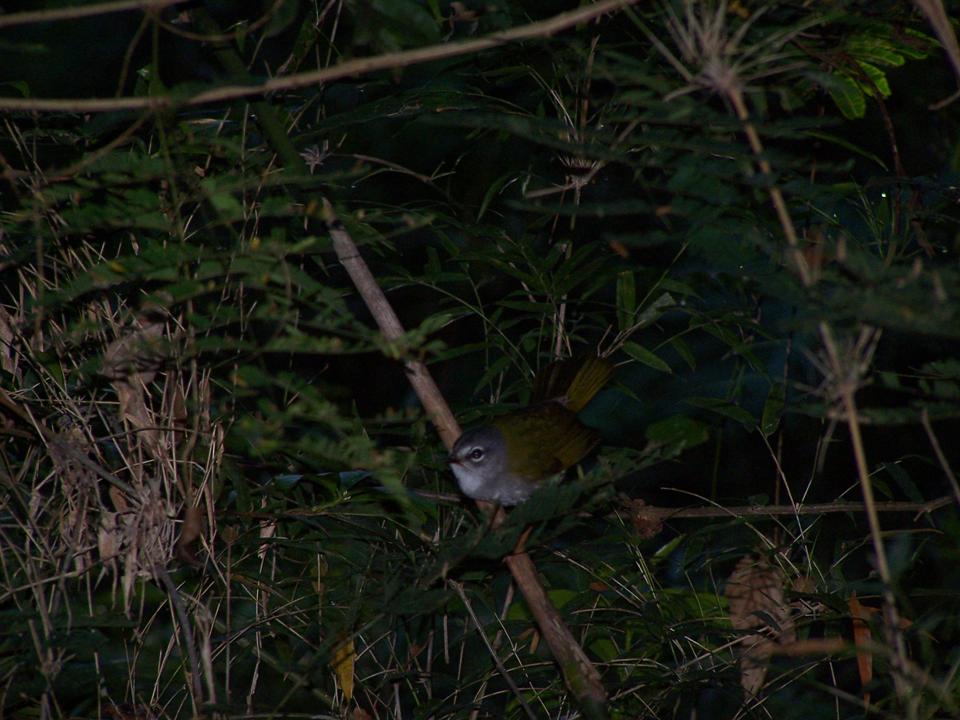

DISTRACTION DISPLAY OF THE WHITE-BROWED WARBLER
Basileuterus leucoblepharus IN PARAGUAY - A SHORT NOTE
Paul Smith
The White-browed Warbler Basileuterus leuscoblepharus is an Atlantic Forest Endemic (Brooks et al 1999) species restricted to southern Brazil, eastern Paraguay, northeastern Argentina and Uruguay (Ridgeley & Tudor 1989). It is a familiar resident of Paraguayan humid forests, though shier and less conspicuous than the congeneric Golden-crowned Warbler Basileuterus culicvorus which often occurs alongside it. Clay & del Castillo (2004) consider the species frequent to common in eastern Paraguay and mist-netting and acoustic studies have suggested that in some areas it is at least as numerous as Golden-crowned Warbler, with an estimated density of more than 300 individuals per km2 (Esquivel 2006, Smith et al. 2006). Unlike the arboreal Golden-crowned Warbler, the White-browed Warbler is semi-terrestrial in behaviour, frequently foraging on the ground, where it moves with a series of hops (Curson et al 1994).

FIG 1: White-browed Warbler Basileuterus leucoblepharus (Photo Paul Smith)
On 14 September 2004 at Hotel Tirol, Departamento Itapúa, southern Paraguay (27o11’S, 55o47´W) a bird of this species was seen engaging in a hitherto undescribed distraction display. It moved in small, tight circles (c30cm in diameter) on the ground with tail fanned, fluttering the spread wings ineffectually as though unable to fly. Simultaneously it gave an unusual, high-pitched pi-pi-pi… call, quite different to the usual harsh pist note of this species (Smith & Clay in press, Curson et al 1994). As it was approached to within 2m the bird began to move slowly away in a straight line, repeating the tight circular paths whenever there was a pause in the observer´s pursuit, imploring him to follow. It proceeded in this manner for c10m before taking flight and perching on a low branch, immediately giving the typical alarm call. The observation was made at the beginning of the southern hemisphere breeding season (broadly September to December) when most species would be expected to be engaged in breeding activity. The behaviour appeared to be designed to lead a potential predator away from a nearby nest, though no nest could be found during a brief search of the immediate area.
Distraction displays are well-documented in many bird families and have been reported for several genera of Wood Warbler in North America (including other semi-terrestrial species such as the Kentucky Warbler Oporornis formosus (McDonald 1998) and the Ovenbird Seiurus aurocapillus (Van Horn & Donovan 1994)). Wing and tail movement play a major role in social interactions and display in the White-rimmed Warbler, as in many other members of its family (Sick 1993) and the distraction display described here is consistent in its basic design with that of other ground-dwelling Parulids - the Kentucky Warbler for example incorporates spread-wings and tail movements into a zig-zagging terrestrial dance leading the threat a safe distance from the nest (McDonald 1998).
This is the first documented description of the distraction display in White-rimmed Warbler, a common but little-studied South American species. Belton (1994) alluded to what was presumably a distraction display by a nesting bird in Rio Grande do Sul, Brazil describing it as “fleeing rapidly and rodent-like with short footsteps while giving a broken wing display”. However that brief description appears to differ in several key elements from the display observed in Paraguay, not least in the path taken by the displaying bird and the speed at which it invited pursuit.
REFERENCES
1.Belton W 1994 Aves do Rio Grande do Sul: Distribuicão e Biologia Universidade do Vale do Rio Dos Santos, São Leopoldo.
2.Brooks TM, Tobias J, Balmford A 1999 Deforestation and Bird Extinctions in the Atlantic Forest Animal Conservation 2: p211-222.
3.Clay RP, del Castillo H 2004 Annotated Checklist of the Birds of Paraguay Guyra Paraguay, Asunción.
4.Curson J, Quinn D, Beadle D 1994 New World Warblers Christopher Helm, London.
5.Esquivel A 2006 Estructura y Organización de una Comunidad de Aves del Bosque Atlántico de la Reserva de Recursos Manejados San Rafael, Paraguay PhD Thesis University of Salamanca, Spain.
6.McDonald MV 1998 Kentucky Warbler (Oporornis formosus). In The Birds of North America, No. 324 (A. Poole and F. Gill, eds.). The Birds of North America, Inc., Philadelphia, PA.
7.Ridgeley RS, Tudor G 1989 The Birds of South America Volume 1: The Oscine Passerines Oxford University Press, Oxford
8.Sick H 1993 Birds in Brazil Princeton University Press, New Jersey.
9.Smith P, del Castillo H, Bankovics A, Hansen L, Wainwright BP 2006 An Avifaunal Inventory of San Rafael “National Park” Departamento Itapúa, Southern Paraguay FAUNA Paraguay Technical Publication 3.
10.Smith P, Clay RP in press A Field Guide to the Birds of Paraguay Christopher Helm, London.
11.Van Horn MA, Donovan TM 1994 Ovenbird (Seiurus aurocapillus). In The Birds of North America, No. 88 (A. Poole and F. Gill, Eds.). The Birds of North America, Inc., Philadelphia, PA.
Designed by Paul Smith 2006. This website is copyrighted by law.
Material contained herewith may not be used without the prior written permission of FAUNA Paraguay.
Photographs on this web-site were taken by Paul Smith, Hemme Batjes, Regis Nossent,
Alberto Esquivel, Arne Lesterhuis, José Luis Cartes, Rebecca Zarza and Hugo del Castillo and are used with their permission.


